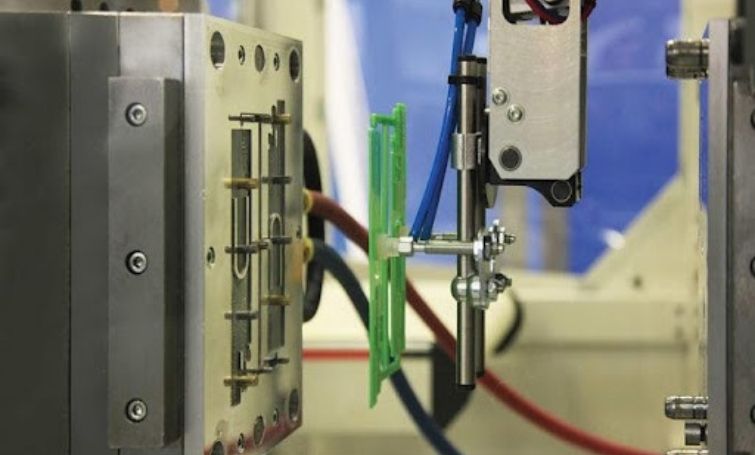How are Plastic Phone Cases Made by Injection Molding?

Everyone has a mobile device in this age and time; if you own one, you probably have protective cases for them. With the increasing popularity of mobile devices in our everyday life, it is not surprising that a phone case is just as important as the device itself.
They serve as a protective cover for your mobile device. This is why people opt for cases that are durable, drop-resistant, and waterproof for their mobile devices. It goes beyond the protective qualities; people want personalized phone cases that can conveniently express their style and reflect their personalities.
Besides, the manufacturing industry for phone cases has been booming over the years and even more this period. Why? Increasing demand for mobile phone cases has also translated to an increase in the market size and profitability of the business.
Material Range for Phone Cases
There are various phone cases available to suit your specific choice and needs. Each of these varying phone cases is made of different materials. The differences in materials confer on each an advantage over the other. Before you shop for your phone cases, you should know what quality is most important to you and the material that will fit the most.
The materials include:
- Flexible plastics such as Silicon and TPU
- Engineering plastics like Polycarbonate, ABS, PP, etc.
- Leather
- Wood
- Carbon fiber.
Here, we will focus primarily on three popular materials for phone cases. Read on to find out the details you should know about its qualities and the manufacturing process.
Silicon Phone Cases
Silicon is a non-metallic compound found in nature, mostly in rocks and sand. Despite not being a metal, it has a shiny metallic shine compared to most metals. It is often employed in most electronic and technology devices because of this crucial quality; it is a semiconductor.
It makes an excellent choice for your phone cases because of its durability and machinability. Machinability means that it can be shaped to fit any form without losing its structure. Silicon phone cases are built to be sleek, lightweight, and have a soft feel when held.
Its soft and rubbery texture makes it anti-slip and less likely to fall off your grip. Of course, it is water-resistant. No wonder most apple phone cases are made of Silicon.
How Injection Molding is Applied for Silicon Phone Cases

The most common techniques used are low-pressure injection molding and compression molding. The custom plastic injection molding technique involves softening the silicon pellets at increased temperature and reduced pressure. At this point, the silicon pellets are liquefied and injected into a mold that matches the shape of the phone case. After it cools and solidifies, it is removed from the mold.
Compression molding, as the name implies, involves compression (increased pressure) and heat to mold the material to assume the shape of the phone case. The Silicon raw material is added into the mold, heated at a specific temperature and pressure until it is soft and malleable. After which, it is allowed to harden and take the shape of its mold. The final product is trimmed to ensure a smooth and sleek finishing.
TPU Phone Cases

TPU is the short form of Thermoplastic Urethane. It is a popular raw material used in making phone cases because of its high rigid texture, and it gives extra protection for your phone. Thermoplastic Urethane is a hard plastic material, unlike Silicon which is soft and pliable.
It offers users a wide range of advantages that protect the mobile device from high impact, wear, and scratches. The material is elastic and can adjust to any shape and style. TPU is liquid-resistant to protect your phone from lubricants like grease and oil.
They are also highly durable, lightweight shock absorbers and can safeguard the phone cases from elements like heat. As earlier stated, it is highly rigid, which protects the phone from forceful impacts.
How Injection Molding is Applied for TPU Phone Cases
For TPU, the first and most crucial step is Drying. The injection machine should remove all the moisture content to achieve a suitable mold that fits the desired shape of the phone case. The acceptable water content should be less than or equal to 0.02%.
Next, the dried TPU is transferred to the mold equipment at a set melt temperature to ensure that the melted TPU leaving through the nozzle is soft and equally smooth. The injection screw shoots the melted TPU to fill the mold cavity at an increased holding pressure and time. After solidifying, the TPU phone case is ejected from the molds.
Engineering Plastics Phone Cases
Engineering materials are durable plastics that make attractive and premium quality phone cases. They are lightweight, durable, and provide suitable physical and chemical properties. Examples are Polycarbonate, Acrylonitrile Butadiene Styrene, and Polypropylene phone cases.
Polycarbonate material is extremely hard, so it is often considered one of the most rigid thermoplastics. Many phone case manufacturers love that it retains both color and durability over time. It is also very resistant to harsh chemicals and moisture, a much-desired characteristic for great phone cases.
ABS phone cases (Acrylonitrile Butadiene Styrene) are popular for cost-effectiveness and absolute moldability. ABS phone cases are resistant to collision no matter how strong the impact, assuring you of your phone’s security anytime it falls off your grip. It also appears glossy because of its shiny surface. Mobile phone cases should be made with highly insulating material, and with ABS, you got that.
Polypropylene (PP) is used in a wide variety of engineering productions, one of which is phone case manufacturing. Like the other engineering plastics, it is semi-hard, semi-transparent, and can withstand elements, pressure, and chemicals.
How Injection Molding is Applied for Engineering Plastics Phone Cases

Injection molding involves adding plastics into a molding machine, letting it mold, and then removal. The injection unit, mold, and clamp are the three most significant parts of the injection molding machine.
As in custom plastic injection molding, the engineering plastics are in pellets. This pellet gets added into the injection unit, then pushed forward by a screw. The machine has radiator bands that warm up the plastic pellets slowly and steadily until the pellets are liquefied.
The molten engineering plastics pellets get injected by the screw into the next unit, the molding machine. After a short while, it solidifies and assumes the mold’s shape before it is removed for the cycle to continue.
How to Start Your Phone Case Business
Are you thinking of starting a phone case business? Starting your own business is not as complicated as you think because of how relevant and profitable the phone case industry is at the moment. Many people are smartphone users, and millions of dollars are spent on mobile devices yearly. These buyers will, in turn, need cases for their devices.
However, because the market is saturated and overly competitive, one has to stand out to succeed. You should not copy what others are doing; instead, let them inspire you. Firstly, you need to identify your niche market and the relevant customer behaviors of the target audience that your business will be serving.
Next, you have to develop a style or design that will directly appeal to your customers. Check out what your competitors have in the market. Create a unique selling point that will differentiate your products and help you outperform them. After which, team up with the professional people who can help you turn your design into reality.
Finally, develop plans on the best ways to advertise your phone cases and how best to market to your target customers (Online stores, drop shipping, social media), etc.
Conclusion
The technological advancement of the phone case industry is playing a significant impact, which is something we all love to see. Unlike before, when phone cases were all about a protective covering, these days, phone cases also represent our style and brand.
FAQs
Injection Molding Plastic Phone Cases are typically made from thermoplastic or thermosetting plastic materials like Polyethylene terephthalate (PET), Polypropylene (PP), ABS, Polycarbonate (PC), Acrylonitrile butadiene styrene (ABS), etc.
The cost of the Injection Molding Plastic Phone Cases varies depending on the size and complexity of the phone case design. Generally, it ranges between a few cents to about US$2 for small cases, and US$2 to around US$50 for more complex cases.
Injection Molding for Plastic Phone Cases provides a high level of accuracy and consistency, allowing for high-quality products with precise detail. Also, because the Plastic Phone Cases are injection molded, they have excellent strength, rigidity, and durability.
The process of making Injection Molded Plastic Phone Cases involves injecting melted plastic into a mold at high pressure, then allowing it to solidify and cool before it is ejected from the mold.
Injection Molding for Plastic Phone Cases does require a skilled and experienced operator to ensure the high quality and consistency of the final product.
Yes, it is possible to make custom designs with Injection Molded Plastic Phone Cases by creating a custom mold with a specific design.
Yes, Injection Molded Plastic Phone Cases are recyclable and can be made with recycled materials.
Generally, the time taken to make Injection Molded Plastic Phone Cases depends on the size, complexity, and customization of the design. It usually takes from 1 to 5 hours to complete.
Injection Molded Plastic Phone Cases can be up to 10 times stronger than their traditional counterparts.
Yes, most Injection Molded Plastic Phone Cases are designed to be waterproof.






